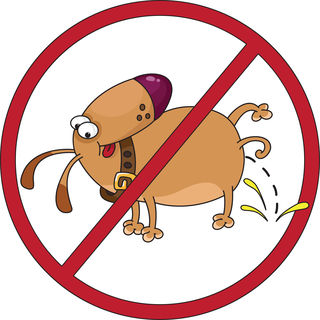Environment
Is House-Training More Effective With Large or Small Dogs?
Recent research shows that success in house-training depends upon a dog's size.
Posted September 10, 2019 Reviewed by Devon Frye

A recent research report from a group of investigators in Virginia has found that the size of a dog predicts how completely and effectively it can be house-trained.
One of the most frequently reported problem behaviors in dogs is house-soiling. Finding (or stepping in) a puddle, or a pile of droppings, is not only unpleasant—it's often accompanied by a surge of negative emotion aimed at the canine culprit. If this is repeated frequently enough, it can greatly weaken the bond between owners and their dog. Frequent house-soiling is the third most common reason why dogs are relinquished to a shelter (behind only aggression and excessive noise).
Dogs are naturally inclined to keep the areas where they sleep and eat clean. In wild canines, like wolves, the mother will keep the den clean by licking the puppies and actually eating their droppings. As soon as the pups are mobile enough, they are taught to urinate and defecate outside of the den.
This genetic predisposition to keep the den clean allows us to house-train dogs. The trick is to convince the dog that the entire house is a den and that there are designated areas (usually outside) which can be used for elimination. Animals with no evolutionary link to living in a den are much more difficult to house-train (think of monkeys, pigs, or horses, where it may be impossible to eradicate soiling in the house).
A team of researchers headed by Amy Learn of the Veterinary Services of Hanover, Behavior Department, in Mechanicsville, Virginia, has recently shown that a dog's size may be associated with its ability to be successfully house-trained. They collected data through an Internet survey, which they made available on an internet survey service (SurveyMonkey) on a number of general veterinary practice and referral center web pages and also on social media pages. The survey asked a number of questions, including about the dog's physical characteristics and whether or not it had had any type of formal obedience classes.
However, the critical question was whether the pet was completely house-trained. The investigators specified that a fully house-trained dog is one that, for at least the last two months (except for extenuating circumstances), has consistently eliminated outside in the environment or in a place designated by the owner. (That designated place could be a pee pad or some sort of litter box setup.)
The first thing that the investigators did was to divide the dogs up by size. Small dogs were defined as those who were 20 pounds (9 kg) or less, and large dogs were defined as those who were 40 pounds (18 kg) or more. To make any possible differences based on size more distinctive, the data from dogs who fell in the middle (between these weight limits) were discarded, leaving a total of 735 cases in the analysis.
The difference in the effectiveness of house-training based on the size of dogs was, at least to me, astonishingly large. In the small dog group, 67 percent were considered to be completely house-trained—leaving 33 percent who, according to their owners, had not achieved the required level of house cleanliness. In comparison, among the large dogs, 95 percent were considered to be fully house-trained, and only 5 percent were judged to be still engaging in house-soiling behaviors.
One surprising additional finding was the fact that the more formal obedience training a dog had received—including basic obedience classes up through competition-level training—the higher the likelihood was that small dogs would be considered to be fully house-trained. The reason that this is surprising is that such standard obedience classes focus on developing the dog's responsiveness to various commands, but do not include any exercises directly related to the prevention of house-soiling.
The effect was much weaker on large dogs—perhaps because so many of them were already considered to be house-trained that there was little room for improvement.
The researchers are at somewhat of a loss to explain their findings. They suggest that it may be the case that small dogs have a relatively high metabolism, and given their small bladder size, they may need to eliminate more frequently. Another possibility is that small dogs may be more common in apartments and dwellings that have no quick outdoor access, meaning that it just may be more difficult to get an excitable dog outside fast enough to avoid accidents.
They do note that this is not the first study to have observed behavioral differences between large and small dogs. One significant set of earlier findings which may be relevant is based upon the fact that achieving house cleanliness requires some form of specific training.
There has been some suggestion that larger dogs are more intelligent (or at least more trainable) than smaller dogs. If true, this could account for these results. However, this investigative team does not seem to be convinced that either of these explanations is the whole answer. Thus, they are left with the simple conclusion that, in the case of house-training, dogs' size matters.
Copyright SC Psychological Enterprises Ltd. May not be reprinted or reposted without permission.
References
Learn, A., Radosta, L., Pike, A., (2019). Preliminary Assessment of Differences in Completeness of House-training Between Dogs Based on Size. Journal of Veterinary Behavior, doi: https://doi.org/10.1016/j.jveb.2019.08.003




